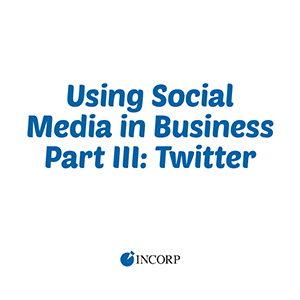Using Social Media in Business Part III: Twitter
As of 2019, Twitter reported more than 320 million active monthly users, which makes this site a very powerful marketing tool, if used correctly. For those who aren't aware of Twitter, it's a short message communication tool that allows users to send out messages (i.e. "tweets") that are up to 280 characters to the people who subscribe to you (i.e. "followers"). Your tweets can include links to other web content including blog posts, articles, or websites), and they can also include photos and videos. The question is then, how can you leverage this immensely popular short-character social media site to drive more traffic to your website, further your brand, and gain more followers?
- First, you'll need to create a Twitter account, complete with an appropriate photo and bio. This is your opportunity to present your brand to the world of Twitter. The tone of your photos, account name, and bio should be consistent with your website and other social media accounts (as well as your future tweets). This will help people identify your business and will continue to build trust with your customers. Make sure your username is also consistent with your other social media accounts, as nothing expresses your brand on Twitter more than your username. This will appear next to all of your tweets, and it is how people will identify you on Twitter.
- You have two opportunities to provide consistent images that relate to your company. Your profile photo will appear next to every tweet, and it's recommended that you use your company logo or a headshot. You also have a profile header, which is a larger background photo that allows you to elaborate on your business. Similar to Facebook's cover photo, this photo will appear at the top of your profile page.
By engaging in the world of Twitter, you can connect with not only future customers but also peers and related businesses in order to further develop your brand and people's awareness of your company.
- Once you've selected a username and photos, it's time to build a strong foundation. You have a small window of opportunity (only 280 characters) in which to elaborate on the details of your company. Make sure you add personality to your bio to pique the interest of potential clients and discuss services (and benefits) you provide. Also, include your location and a link to your website and/or blog.
- Research, research, research. Determine the areas you want to target and search for customers, business partners, suppliers, contractors, vendors, competitors, and peers, as well as professional and trade organizations for your industry. You should follow these people, as well as businesses in your neighborhood and companies run by people you know (i.e., your professional network). You can use Twitter to find like-minded customers and media by conducting a search using keywords related to your industry. Once you find and follow them, you should start interacting with them on a regular basis.
- Make sure you tweet regularly. Frequent, consistent, and relevant tweets are imperative. You'll remain on everyone's mind if you're consistent.
- Make sure you tweet regularly. Frequent, consistent and relevant tweets are imperative. You'll remain on everyone's mind if you're consistent.
- Don't be shy. It's okay to ask your followers to retweet, mention or favorite your tweets. It's also good to request that they share your content with their own tweets. Word-of-mouth is important to maintaining a successful small business.
- You should retweet and favorite other people's tweets as well. Oftentimes, opting to favorite someone's tweet will get more attention than a retweet or a mention, but you should consistently do all of the above.
- Follow all of the changing trends and various hashtags. Find a way to make a relevant connection with whatever is trending and link it to your brand so you can capitalize on it.
- Offer discounts and deals to your followers. You can create fun contests, (i.e. providing the first 30 people who retweet a specific post with a coupon for 20% off.) You should also encourage (and reward) people who post pictures of themselves in your store or using your product.
- Make sure you're following all of the comments and mentions your company and brand receives. This way, you'll know what is being said about you, and you can make sure you're responding in a polite, professional, and timely manner.
- Use Twitter Analytics to see what is resonating with your audience and what isn't, so you can modify your tweets or stay the course if you're receiving a positive response.
Bottom Line: By engaging in the world of Twitter, you can connect with not only future customers but also peers and related businesses in order to further develop your brand and people's awareness of your company.
Utilizing Social Media in Business:
Facebook | Instagram | LinkedIn | YouTube | Pinterest | TikTok | Sites to Use
Stay in the know!
Join our newsletter for special offers.

